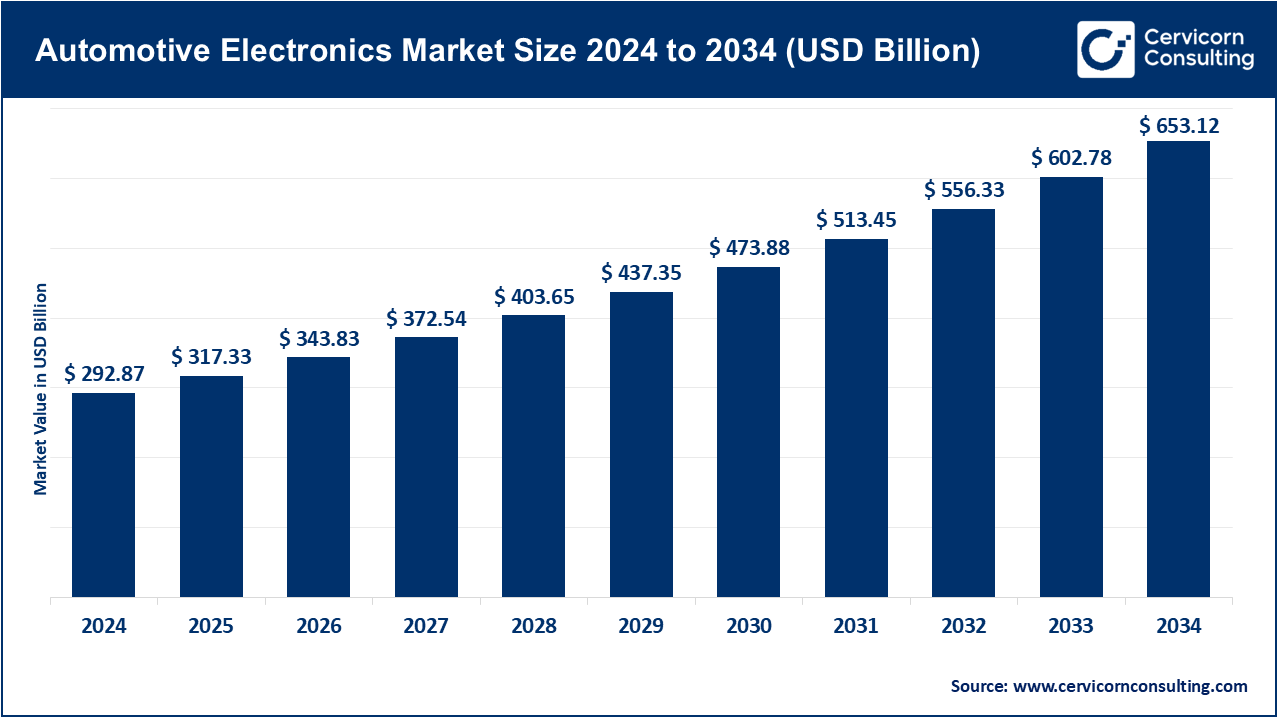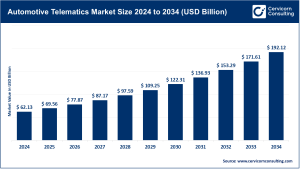Automotive Electronics Market Overview
In 2024, the global automotive electronics market is valued at approximately USD 292.87 billion and is projected to exceed USD 653.12 billion by 2034, growing at a CAGR of 9.2% from 2025 to 2034. This growth is primarily driven by the rising adoption of electric vehicles (EVs), stricter regulatory standards, and the increasing integration of smart technologies in both passenger and commercial vehicles.
The market has experienced rapid expansion in recent years due to technological innovations, heightened vehicle electrification, and growing consumer interest in connected and intelligent vehicles. Automotive electronics include systems such as infotainment, telematics, advanced driver-assistance systems (ADAS), sensors, and electronic control units (ECUs).
Get a Free Sample: https://www.cervicornconsulting.com/sample/2696
Key Market Trends
Electrification of Vehicles:
The shift from internal combustion engines (ICE) to electric vehicles is increasing demand for battery management systems, inverters, power electronics, and charging infrastructure. Companies like Tesla and BYD are incorporating sophisticated electronic modules to enhance EV performance.
Advanced Driver-Assistance Systems (ADAS) and Autonomous Driving:
Consumer demand for safety and automation is driving the adoption of ADAS technologies such as lane-keeping assist, adaptive cruise control, and collision avoidance. Bosch and Continental are expanding their offerings to support Level 2 and Level 3 autonomous driving.
Connected and Smart Vehicles:
IoT-enabled infotainment, telematics, and vehicle-to-everything (V2X) connectivity are becoming standard, improving user experience, predictive maintenance, and fleet management.
Regulatory Push for Safety and Emissions:
Governments worldwide are enforcing stricter safety, fuel efficiency, and emission standards (e.g., Euro 7, CAFE), encouraging the adoption of electronics that optimize engine performance and monitor compliance.
Consumer Preference for Personalization and Comfort:
Electronics enhancing the in-car experience—such as smart dashboards, touchscreens, and climate control—are increasingly influencing buying decisions.
Market Drivers
Rising Vehicle Production:
Global vehicle output, particularly in Asia-Pacific, is experiencing significant growth in EVs and smart vehicles, fueling demand for electronic components.
Technological Advancements:
Innovations in semiconductors, sensors, and ECUs allow for advanced features while reducing costs and component sizes.
Government Incentives:
Subsidies and incentives for EV adoption and emission reduction across Europe, North America, and China are supporting demand for electronic systems.
Consumer Demand for Safety and Connectivity:
Growing awareness and preference for smart, connected features are pushing automakers to integrate electronics extensively. For instance, ADAS penetration is expected to exceed 70% of new vehicles by 2030.
Impact of Trends and Drivers
Regional Impact:
Asia-Pacific leads, driven by China, Japan, and South Korea, due to large-scale EV production, favorable regulations, and tech-savvy consumers. North America and Europe follow, supported by luxury vehicle markets and stringent regulatory frameworks.
Segmental Impact:
ADAS, power electronics, and infotainment systems are the fastest-growing segments, while traditional ECUs and basic electronics experience moderate growth.
Application Impact:
Passenger vehicles are the primary adopters of advanced electronics, though commercial vehicles are increasingly integrating telematics, fleet management, and safety solutions.
Challenges & Opportunities
Challenges:
-
High development costs for autonomous and connected vehicle systems
-
Semiconductor and component supply chain constraints
-
Cybersecurity risks in connected vehicles
Opportunities:
-
Expanding EV market driving demand for battery management and power electronics
-
Smart city and V2X infrastructure integration creating new revenue streams
-
Rising aftermarket electronics demand for vehicle personalization and upgrades
Future Outlook
Emerging trends include AI-driven autonomous driving, next-generation infotainment, wireless EV charging, and lightweight electronic components. Companies investing in innovation, partnerships, and regional expansion are well-positioned to capture opportunities in this evolving market.
For more detailed insights, contact us: Contact Us
Read: Structural Steel Market Size, Trends, Drivers, and Regional Analysis 2025-2034

